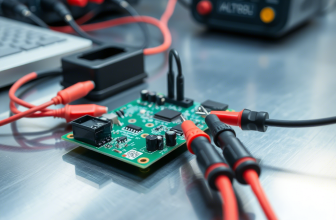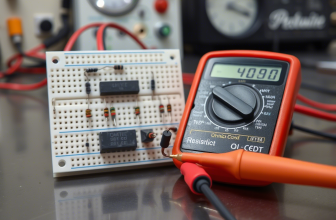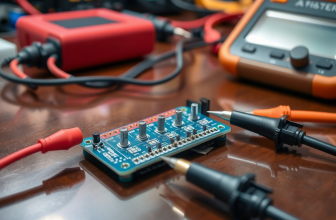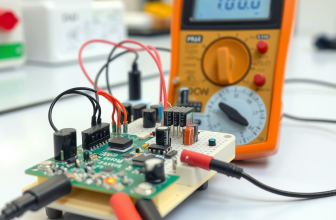Measuring frequency with a multimeter might sound like something only electronics experts do, but the truth is, anyone can learn how.
Whether you’re trying to figure out why your audio system sounds distorted, your power supply isn’t working properly, or you’re just curious about how electricity behaves, knowing how to measure frequency can be incredibly useful.
Table of Contents
In this article titled “Multimeter How to Measure Frequency,” we’ll walk you through everything you need to know in simple, easy-to-understand language. No confusing jargon, no complicated math—just clear instructions for complete beginners.
Frequency refers to how often an electrical signal repeats over time, and it plays a crucial role in many aspects of electronics and power systems. Learn more for frequency on GeeksforGeeks.
For example, the electricity coming from your wall outlet has a standard frequency—60 Hz in North America and 50 Hz in most other parts of the world. If that frequency deviates significantly, it can cause appliances to malfunction.
Similarly, in audio equipment, frequency determines the pitch of a sound, and in digital circuits, frequency governs how fast a device operates. Measuring frequency helps determine whether these signals are within their expected range, making it an invaluable skill for troubleshooting electronics, repairing appliances, or even understanding how circuits work.
In this guide, “Multimeter How to Measure Frequency,” we’ll explain exactly what frequency is, how it works, and how to use your multimeter to measure it safely and accurately.
You don’t need any prior experience or special tools—just a little patience and a willingness to learn.
We’ll also cover safety tips, common mistakes to avoid, and real-life examples of how to test different types of signals. So let’s get started and take the mystery out of measuring frequency!
What Is Frequency and Why Measure It?
Before diving into the process of measuring frequency with a multimeter, it’s important to understand what frequency actually is and why checking it matters.
In the simplest terms, frequency refers to how often an electrical signal repeats itself in one second. It is measured in hertz (Hz), named after the German physicist Heinrich Hertz. One hertz means one cycle per second.
For example, if you hear a pure musical note that vibrates 440 times every second, that note has a frequency of 440 Hz.
In electrical systems, frequency plays a crucial role in determining how devices function. The electricity that powers your home runs at either 50 Hz or 60 Hz, depending on your country.
This consistent frequency ensures that motors, clocks, and other appliances operate correctly. In electronics, frequency determines how fast a circuit switches between states, which affects performance in devices like radios, computers, and communication systems.
Audio signals also rely on frequency—low frequencies produce deep bass tones, while high frequencies create sharp treble sounds.
There are many practical reasons to measure frequency with a multimeter. One of the most common uses is diagnosing power supply issues. If your lights flicker, your motor hums oddly, or your audio amplifier produces strange noise, the problem might be related to incorrect frequency levels.
By using a multimeter to check the frequency of the power source or signal input, you can quickly determine whether it falls within acceptable limits or needs correction. Another valuable application is verifying component specifications, especially when working with salvaged or older parts.
Sometimes, electronic components lose their markings over time, making it hard to tell their intended operating frequency. Measuring frequency allows you to confirm whether a component is functioning within its expected range before incorporating it into a new circuit.
Additionally, measuring frequency helps detect signal distortions or interference in electronic circuits. Many digital and analog devices rely on precise frequency control to function properly.
If a signal’s frequency drifts outside its designed range, it can cause malfunctions, poor performance, or even damage sensitive components. Some advanced multimeters include a dedicated frequency measurement mode, which provides more accurate results than basic voltage or resistance checks.
Even standard multimeters with frequency capabilities allow you to gain valuable insight into how electrical signals behave in various applications.
By understanding frequency and how to measure it, you gain a powerful tool for diagnosing and fixing electrical problems.
Whether you’re working on home electronics projects, repairing appliances, or simply trying to understand how circuits work, knowing how to measure frequency gives you valuable insight into the behavior of electrical systems.
Preparing Your Multimeter for Frequency Measurement
Now that you understand what frequency is and why it’s important to measure it, it’s time to prepare your multimeter for the task.
Unlike measuring voltage or resistance, measuring frequency requires a slightly different setup, and it’s crucial to do it correctly to ensure accurate readings.
This section of “Multimeter How to Measure Frequency” will guide you through the necessary steps to ensure you’re ready to proceed safely and effectively.
First, locate the dial or selection knob on your multimeter. This is usually found near the center of the device and allows you to choose what type of measurement you want to take—in this case, frequency.
On most digital multimeters that support frequency measurement, there is a dedicated setting marked with a capital “Hz,” which stands for hertz, the unit used to measure frequency.
If your multimeter does not have an auto-ranging feature, you may need to manually select the appropriate frequency range based on what you expect the signal to be. Some models offer multiple frequency ranges, such as 20 Hz, 200 Hz, 2 kHz, and so on.
If you’re unsure, start with a mid-range setting like 2 kHz and adjust as needed after taking an initial reading.
Next, insert the test leads into the correct ports on your multimeter. When measuring frequency, the black lead should always go into the port labeled “COM,” which stands for common. This is your reference point.
The red lead goes into the port labeled “VΩHz” or something similar, which is designated for measuring voltage, resistance, and frequency.
Some multimeters have a separate frequency input jack labeled specifically for this function, so always refer to your device’s manual to confirm the proper placement of your leads before proceeding.
Using the wrong port can result in inaccurate readings or damage to the multimeter, so always double-check the setup before taking measurements.
One important thing to note when measuring frequency is that most multimeters require the signal to be in the form of a voltage waveform. This means you cannot directly measure the frequency of current alone—you must measure the voltage signal associated with the frequency you’re testing.
For example, when measuring the frequency of an AC power supply, you would place the probes across the power line to capture the alternating voltage waveforms.
Similarly, when testing an audio signal from a speaker output, you would connect the probes to the speaker terminals to read the frequency of the electrical signal driving the sound.
Once your multimeter is set up, it’s a good idea to perform a quick calibration step, especially if you’re using an older model.
Some multimeters have built-in calibration features, but if yours doesn’t, you can verify accuracy by testing a known frequency source, such as a signal generator or a digital clock circuit.
If the displayed frequency matches the expected value, your meter is functioning correctly. If not, consult your multimeter’s user manual for calibration instructions or consider replacing the battery if readings appear inconsistent.
With everything set up correctly, you’re now ready to begin measuring frequency. In the next section of this guide, “Multimeter How to Measure Frequency,” we’ll walk you through step-by-step instructions for testing various types of signals.
Multimeter Deals
Step-by-Step Instructions: How to Measure Frequency with a Multimeter
Now that your multimeter is properly set up, it’s time to put it into action and measure frequency in a real-world scenario. This section of “Multimeter How to Measure Frequency” will walk you through the process in clear, easy-to-follow steps.
Let’s begin with a simple example: measuring the frequency of household AC power. This is a great starting point because it demonstrates how to measure frequency in a common and safe environment.
Start by ensuring that your multimeter is set to the frequency measurement mode. As discussed earlier, look for the “Hz” symbol on the dial and turn the selector to that position.
If your multimeter has multiple frequency ranges, choose one that suits your expected measurement. Since household electricity in North America typically runs at 60 Hz, selecting the 200 Hz range is a safe bet. If your multimeter has an auto-ranging function, you won’t need to worry about selecting the right range—the multimeter will adjust automatically.
With the multimeter set up, identify where you want to take your measurement. For this example, we’ll measure the frequency of the electricity coming from a standard wall outlet.
Before proceeding, make sure the outlet is functioning and currently supplying power. Place the red probe into the narrower slot of the outlet (this is the live wire) and the black probe into the wider slot (the neutral wire).
Alternatively, you can touch the black probe to a grounded metal object, such as a screw on the outlet cover plate or a metal water pipe, to establish a ground reference.
As soon as the probes make contact, the multimeter should display the frequency of the AC power. In most cases, you should see a reading close to 60 Hz (or 50 Hz in countries that use a 50 Hz power grid).
If the reading is significantly off, such as showing 50 Hz in a 60 Hz region or fluctuating wildly, it could indicate a problem with the power supply. However, minor fluctuations within a few tenths of a hertz are normal due to variations in load and grid conditions.
Let’s try another example: measuring the frequency of an audio signal. Suppose you want to test the output of a guitar pedal or an audio amplifier to see if it delivers the correct tone. Start by turning on the audio device and playing a steady note or tone.
Set your multimeter to the frequency measurement mode and place the red probe on the positive terminal of the audio output and the black probe on the ground or negative terminal.
The multimeter should immediately display the frequency of the audio signal. For instance, if you’re playing a middle C note on a piano or tuning fork, you should expect a reading around 261 Hz.
If the reading is far off or shows erratic values, it may indicate a problem with the audio circuitry or wiring. This technique is particularly useful when troubleshooting speakers, amplifiers, or synthesizers where precise frequency output is essential for sound quality.
Another common application is measuring the frequency of a digital square wave, such as those found in microcontroller circuits or pulse-width modulation (PWM) signals. To test this, set your multimeter to the frequency mode and place the probes on the signal source—such as a pin on a microcontroller or a motor speed controller.
The multimeter should display the frequency of the signal being sent to the connected device. For example, a motor controller might send a 1 kHz (1,000 Hz) signal to regulate fan speed, and your multimeter should reflect that value if everything is working correctly.
As you practice measuring frequency in different setups, keep in mind that consistency and proper technique are key to obtaining accurate results.
Ensure that the probes make solid contact with the test points, avoid touching exposed metal parts with your hands, and always double-check your multimeter settings before taking a measurement.
By following these simple guidelines, you’ll quickly become comfortable with the process described in this section of “Multimeter How to Measure Frequency.”
Understanding completely Frequency Readings
Once you’ve taken a frequency measurement, the next step is understanding what the numbers on your multimeter mean.
In this part of “Multimeter How to Measure Frequency,” we’ll break down how to interpret the readings you see on the display and what they signify about the signal you’re testing.
While the exact appearance of the display may vary slightly depending on your multimeter model, most digital versions will show a numerical value followed by a unit of measurement—typically hertz (Hz), kilohertz (kHz), or megahertz (MHz).
Let’s start with basic frequency values. Suppose you measured the frequency of a wall outlet and saw a reading of 60.1 Hz. This means the alternating current (AC) power supply is running slightly above the standard 60 Hz, but still within a normal range.
Most household power supplies have small fluctuations due to changes in demand, weather conditions, or grid adjustments, so seeing a reading between 59 Hz and 61 Hz is perfectly normal.
If the reading drops below 58 Hz or rises above 62 Hz, it could indicate a problem with the power supply, which might affect the performance of certain appliances, especially those with electric motors.
When measuring audio signals, the expected frequency values depend on the type of sound you’re testing. For example, if you tested a tuning fork that emits a middle C note, you should expect a reading around 261 Hz.
If you’re measuring a bass-heavy sound, such as a subwoofer output, you might see frequencies between 20 Hz and 200 Hz, while higher-pitched sounds like cymbals or whistles fall in the 2 kHz to 20 kHz range.
If the reading is significantly lower or higher than expected, it could suggest an issue with the audio circuit, speaker, or amplifier.
Another thing you might encounter when interpreting frequency readings is an “OL” symbol on the display. This stands for “Overload” and appears when the frequency you’re measuring exceeds the selected range on your multimeter.
For instance, if you set your multimeter to the 200 Hz range but attempt to measure a 1 kHz signal, the display will show “OL” because the frequency is too high for that setting. To resolve this, simply adjust the multimeter’s dial to a higher frequency range and try again.
Some modern multimeters have auto-ranging capabilities, which automatically detect and display the correct frequency without requiring manual adjustments.
If your multimeter has this feature, you won’t see an overload warning unless the frequency exceeds the device’s maximum limit, which is typically several megahertz.
It’s also important to note that minor variations in readings are normal and don’t necessarily indicate a problem. Environmental factors, signal quality, and the precision of your multimeter can all influence the accuracy of the measurement.
As long as the reading stays within an expected range for the signal you’re testing, there’s generally nothing to worry about.
With this knowledge, you’ll be better equipped to assess whether the frequency levels you’re measuring are within acceptable limits, allowing you to make informed decisions about your electrical or audio equipment.
Common Mistakes and Safety Tips When Measuring Frequency
While measuring frequency with a multimeter is generally safe when done correctly, there are some common mistakes that beginners often make. One of the most frequent errors is attempting to measure frequency in a live high-voltage circuit without proper precautions.
Although measuring frequency is less risky than measuring current, it still involves connecting the multimeter to a powered circuit, which can pose hazards if not handled carefully.
Always ensure the circuit is powered down before making connections, and never measure frequency in industrial or high-power systems unless you have the proper training and protective gear.
Another mistake many newcomers make is using the wrong multimeter setting. Some multimeters have a dedicated frequency mode, while others require you to use the voltage measurement setting to indirectly measure frequency.
If you accidentally leave the multimeter in resistance or continuity mode instead of voltage or frequency mode, you might get incorrect readings or even damage the device.
Always double-check your multimeter’s dial position before taking any measurements, especially if you’ve recently used it for other tests like resistance or current.
Incorrectly placing the test leads is another issue that can lead to confusion or inaccurate data. Unlike measuring resistance or voltage, where polarity matters in some cases, frequency measurements are generally not affected by probe orientation.
However, ensuring good contact with the test points is essential for accurate readings. If the probes aren’t making solid contact with the signal source, the multimeter may pick up interference or display erratic values.
Always make sure the probes are securely placed on the test points and avoid touching exposed metal parts with your hands to prevent interference.
Additionally, failing to clean the test points before measuring can introduce unwanted resistance or interference. Dirt, oxidation, or corrosion on the surface of wires or terminals can affect signal transmission, leading to false readings.
Before placing the probes on a component, gently wipe the connection points with a clean cloth or lightly sand them to remove any debris or tarnish. This ensures a solid connection and improves the accuracy of your frequency measurements.
Lastly, attempting to measure frequency in high-current or unstable power sources can lead to unexpected results. Some multimeters struggle with frequency measurements in noisy environments or when dealing with distorted waveforms.
If you’re testing a signal that appears irregular or fluctuates rapidly, consider using an oscilloscope for more detailed analysis. However, for basic frequency checks, your multimeter should provide sufficient information as long as you follow proper techniques and safety measures.
By being mindful of these common pitfalls and following basic safety precautions, you can ensure that every frequency check you perform is both accurate and secure.
Troubleshooting Electrical Problems with Frequency Measurements
Now that you know how to measure frequency and interpret the readings, let’s explore how to use this knowledge for troubleshooting common electrical issues.
In this section of “Multimeter How to Measure Frequency,” we’ll walk through real-world scenarios where measuring frequency can help identify problems in everyday devices and circuits.
Whether you’re dealing with a malfunctioning power supply, an unstable audio signal, or a faulty motor controller, a multimeter can be a powerful diagnostic tool.
Let’s start with a simple example: a desktop computer power supply that causes occasional system crashes or reboots. Power supplies convert alternating current (AC) from the wall outlet into direct current (DC) for the computer’s internal components. If the incoming AC frequency is unstable, it can cause power fluctuations that affect system stability.
To test this, set your multimeter to frequency mode and place the probes across the AC input terminals of the power supply.
In most North American homes, the frequency should be close to 60 Hz. If the reading fluctuates significantly or consistently reads below 58 Hz or above 62 Hz, it suggests an issue with the power grid or a faulty power conditioner.
Replacing a damaged surge protector or contacting your utility provider can help resolve the issue.Learn more how surge protector works.
Another common scenario involves an audio amplifier that produces unusual humming or distortion. Sound systems rely on precise frequency handling to deliver clear audio. If a speaker or amplifier is producing abnormal noise, it could be due to an incorrect frequency response or interference.
To test this, play a steady tone through the system and measure the frequency at the amplifier’s output terminals. A healthy audio signal should match the frequency of the original tone. If the measured frequency is inconsistent or differs significantly from the expected value, it may indicate a problem with the amplifier’s circuitry, such as a faulty capacitor or oscillator.
Replacing the defective component can restore proper signal processing and improve sound quality.
Household appliances can also benefit from frequency checks. Imagine a washing machine motor that struggles to spin at the correct speed or makes unusual noises. Many single-phase AC motors rely on stable frequency to maintain proper operation.
To test the motor’s power supply, set your multimeter to frequency mode and measure the AC signal at the motor’s power terminals. A healthy motor should receive power at the standard 60 Hz (or 50 Hz in some regions).
If the frequency is significantly off or fluctuates constantly, it could indicate a problem with the motor’s control board or external power source. Identifying and resolving frequency inconsistencies can prevent premature wear on mechanical components and extend the life of the appliance.
By systematically checking frequency at different points in a circuit, you can isolate the source of the problem and avoid unnecessary replacements.
Whether you’re troubleshooting electronics, automotive systems, or household gadgets, knowing how to measure frequency gives you a valuable advantage in diagnosing and resolving electrical issues efficiently.
Expanding Your Multimeter Skills: Beyond Basic Frequency Checks
Now that you’ve mastered the fundamentals of measuring frequency with a multimeter, you can begin exploring additional ways to use your tool for more advanced diagnostics.
In this final section of “Multimeter How to Measure Frequency,” we’ll introduce a few practical applications that build upon your newfound skills, helping you get the most out of your multimeter.
While frequency measurement is an essential starting point, your multimeter can also assist with checking pulse width modulation (PWM), analyzing sensor signals, and even identifying electrical noise in circuits.
One particularly useful skill is learning how to test pulse width modulation (PWM) signals. PWM is commonly used in motor controllers, LED dimmers, and power supplies to regulate energy delivery efficiently.
By measuring the frequency of a PWM signal, you can determine whether the controller is operating within its intended range. For example, a typical motor speed controller might use a 5 kHz signal to regulate fan speed.
If your multimeter shows a drastically different frequency—say, only 500 Hz—it indicates a fault in the control circuit, possibly due to a damaged capacitor or oscillator. Diagnosing and repairing this issue can restore normal operation without needing to replace the entire unit.
Testing sensor signals is another valuable application that builds on your frequency-measurement knowledge. Many sensors, such as those found in engine control units (ECUs), HVAC systems, and industrial automation, generate frequency-based outputs to communicate data.
For instance, a vehicle’s crankshaft position sensor sends a frequency signal to the ECU to determine engine speed. If the sensor fails or sends an inconsistent signal, the engine may run poorly or fail to start altogether.
By measuring the sensor’s frequency output while cranking the engine, you can determine whether the sensor is functioning correctly.
A healthy crankshaft sensor typically generates a signal between 100 Hz and 2,000 Hz, depending on engine speed. If the reading is erratic or completely absent, it indicates a potential failure that may require replacement.
Another practical use of frequency measurement is identifying electrical noise in circuits. Unwanted interference can disrupt signal integrity in audio equipment, radio transmitters, and digital circuits.
By measuring frequency at various points in the circuit, you can pinpoint sources of interference. For example, if you notice an unexpected 60 Hz hum in an audio system, it may indicate improper grounding or interference from nearby power lines.
Tracking down the source of this noise allows you to implement shielding or filtering solutions to eliminate the problem.
By expanding your frequency-testing techniques beyond basic checks, you gain a more comprehensive toolkit for diagnosing and repairing electrical problems.
Whether you’re verifying PWM signals, assessing sensor health, or tracking down hidden faults in electronics, these additional skills enhance your ability to troubleshoot effectively.
With consistent practice and exploration, your multimeter will become an indispensable companion in both everyday fixes and more complex electronic projects.








